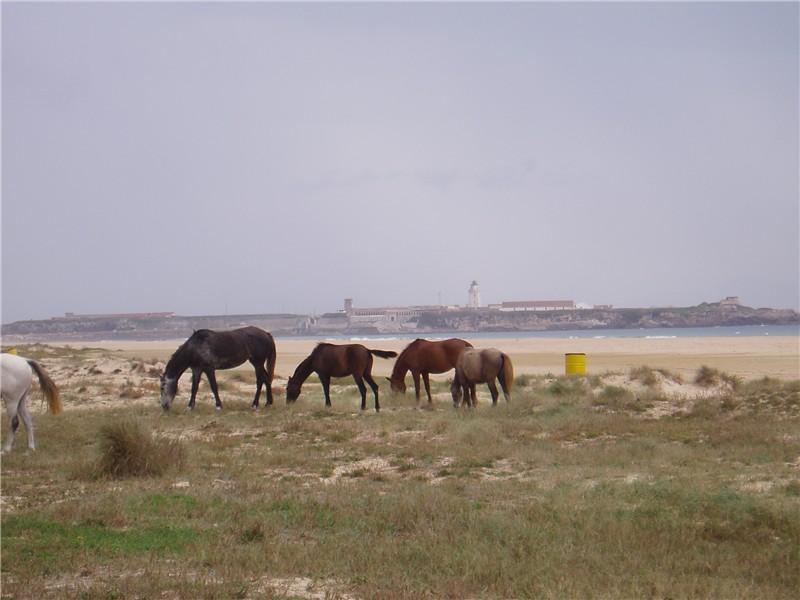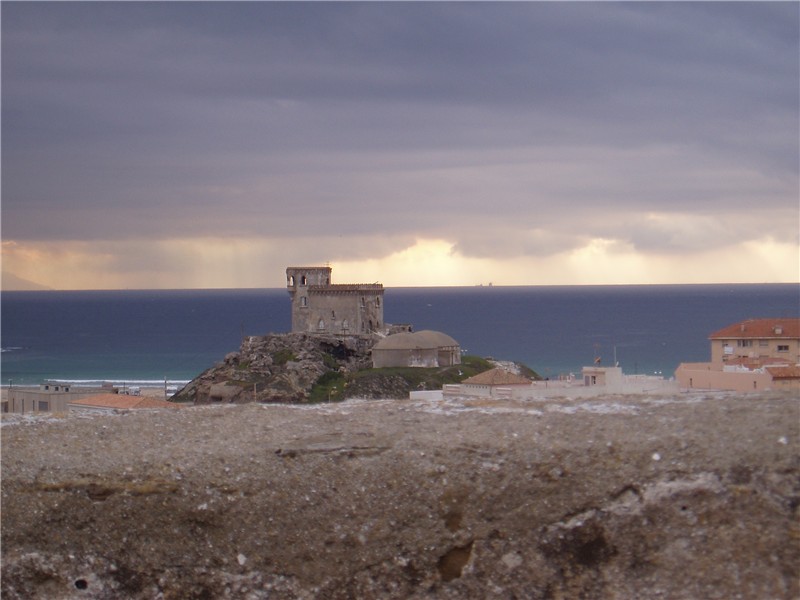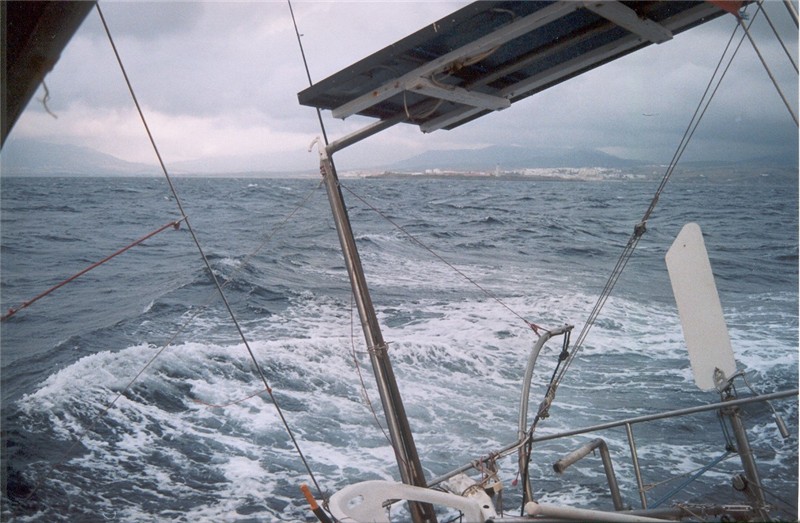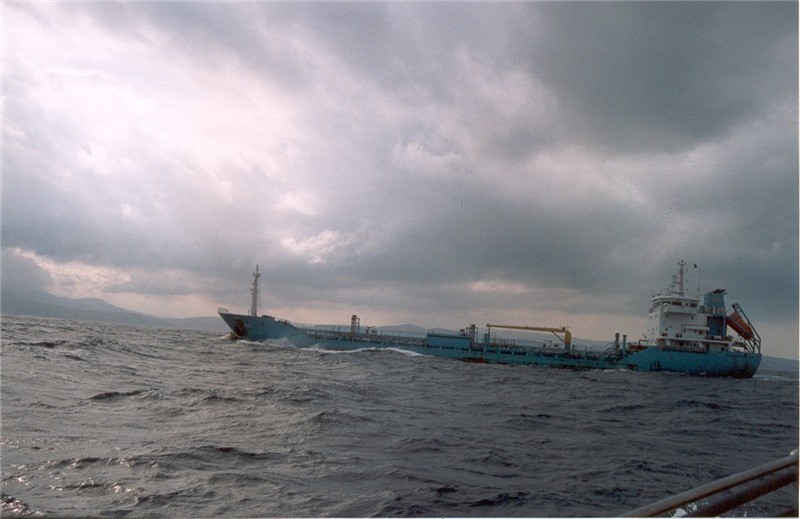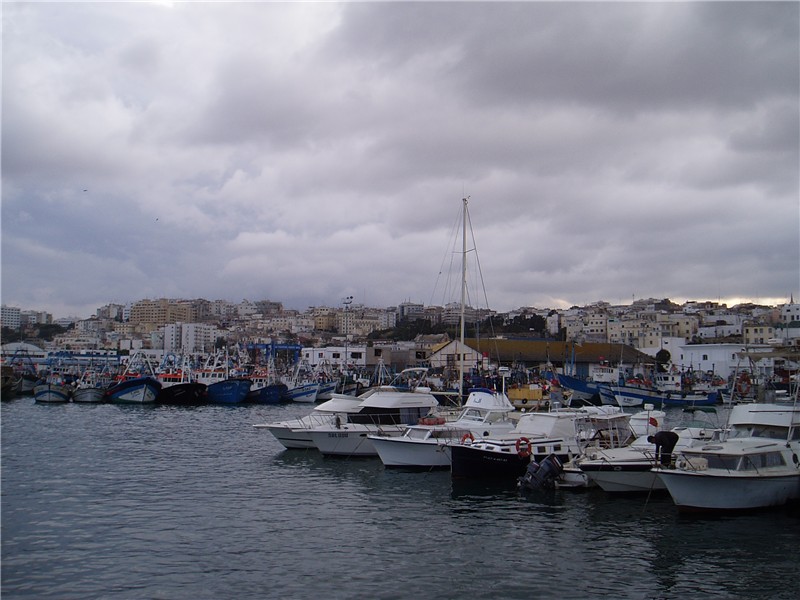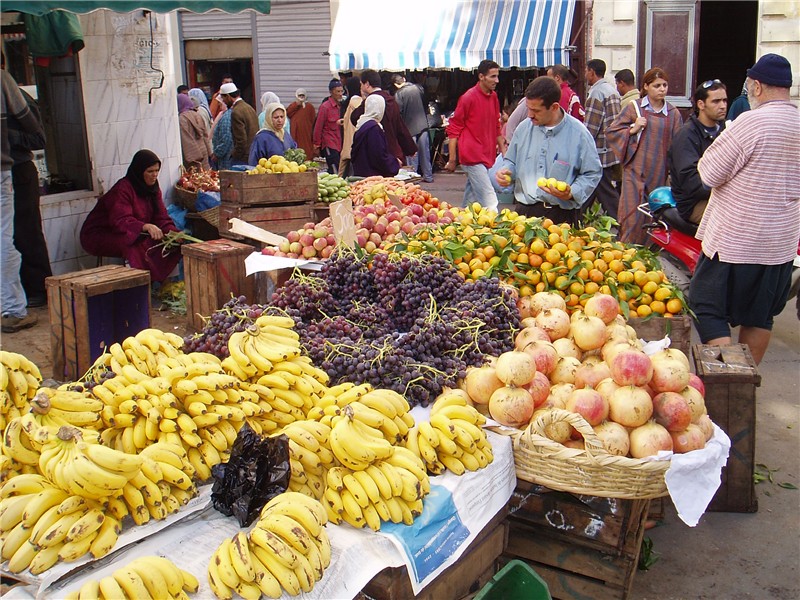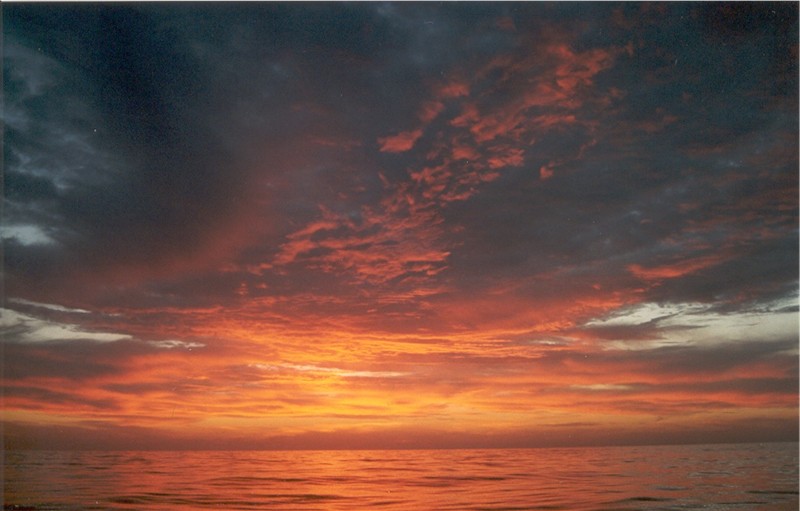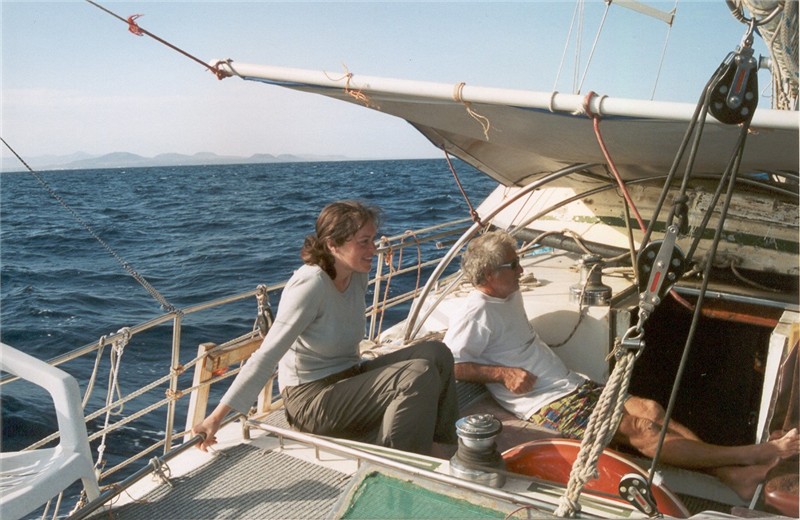FROM GIBRALTAR TO CANARY ISLANDS:
30 DAYS AT SEA (AND LAND)

|
Part 2 Gibraltar to Tangia
|
||
|
The warm Mediterranean Sea evaporates faster than the intake from the rivers that feed it, and this thirst is in turn quenched by the Atlanta Ocean through the Gibraltar Strait. The current resulting from this steady flow of water works together with the incoming tide against vessels trying to sail to the Atlantic. This flow of water can be as fast as 5 knots. Wallaby Creek’s modest diesel engine power can drive the boat at 6 knots in a calm sea. To avoid the worst part of the current, we sail west along the coast of Spain first, to the port of Tarifa which is directly across Tangia, and then we will cross the Strait. This early morning is overcast and misty, but warm. Not a drop of wind; the water is flat as glass, broken only by some occasional, strange ripples driven by the current that swirls like mini whirlpools. Gibraltar slowly disappears behind us, the Rock dramatically profiled by the rising sun as the sky begins to clear up. By noon we are at Tarifa. An ancient city strategically guarding the Strait of Gibraltar at the Atlantic entrance, Tarifa dates back to Roman times. The yachting guide book recommends against it, citing poor facilities, but the harbor turns out to be excellent and the dock is empty except for some deep-sea fishing boats. The harbor is protected in all directions by huge sea-walls that are about 10 meters high and built of huge rocks and concrete - an indication of the conditions here when it gets stormy.
Horses roaming on the deserted beach at Tarifa This is the southern-most tip of the Iberian Peninsula, the wind-swept Atlantic frontier of the old Spanish empire. South Carolina is directly across the ocean, about a 4-week sailboat journey with good winds. Ocean breakers roll up a wide, sandy beach that stretches north as far as the eye can see. Some horses roam freely on the deserted beach.
The Castle de Guzman El Bueno was built in the ninth century and reflects the mix of Muslim and Christian architecture common in the region. In 1294, a knight named Guzman El Bueno sacrificed his own son rather than surrendering the Castle that he had been entrusted with by his king, and his enemy retreated in honor of his loyalty. There are no battle cries echoing off the tall castle walls now as we climb up the watch tower, only storm clouds building as a cold Atlantic air mass clashes with the warm Mediterranean air:
Storm clouds gathering
The next morning daybreaks grey, cold and windy. Forecast calls for 25 knots wind, but in the protected harbor the water is calm and the view of the ocean is hidden by the tall sea walls. The only hint of the wind condition is from the flags which fly on poles high above the seawall – flags held straight and flat as a plywood board by the wind. A wind speed of 25 knots is considered breezy but nothing unusual for ocean-crossing vessels, so we don our foul-weather gear and prepare to take off. Sail areas are reduced by using a smaller stay sail for the jib and reefing the mainsail, but sails cannot be hoisted yet as we need to motor out the waterway to leave the harbor. The full force of the stormy sea is hidden until we turn the corner around the last stretch of seawalls: Two-meter waves dotted with white caps crash onto the rocky shore and explode into thunderous showers, and the small engine struggles against the wind and the waves as we turn into the wind in order to raise the sails. It is an eastern wind that roars down the Strait, and the direction towards Gibraltar puts the wind on the beam of the boat – great for sailing but makes a somewhat uncomfortable ride. Allen engages the wind-driven auto pilot, and mostly we simply sit in the cockpit and watch the boat sail itself. Running at a hull-speed of 6 knots, Wallaby Creek cuts through the waves effortlessly. The cross-current occasionally generates a larger wave of about 3 meters, and puts the boat over her side to the rub rail. Occasionally a wave crashes on the windward side and splashes into the cockpit in a salty spray that showers everyone, but mostly Wallaby is well-behaved and ships little water.
Stormy seas at the Strait of Gibraltar
Under a grey sky laden with clouds the Spanish coast quickly disappears behind us. We spot two dolphins following us about 50 meters away, two dark shapes that play with the wakes and leap above them. Through the morning the wind continues to be strong and steady as a storm front moves in. Anything loose in the cabin is being thrown about. The toilet backflows and gets part of the carpet wet; we hope it’s just sea water. After a while we got used to the pitching and crashing, and begin to relax and enjoy the exhilarating ride. At noon time, my turn to cook, I got ambitious and decide to make scrambled eggs and bacon for brunch. Try this at home: scrambled eggs in a large bowl two-thirds full, incline it at an angle of 20 degrees, walk quickly across the kitchen, and rapidly stop. You will find that most of the solution leaps out and ends up on the floor. That is what happened with me. Down inside the boat in the galley, one cannot see the wave motions and can only hold onto whatever is nearby and try to allow for wild movements of the boat- not always successfully. As we cross the shipping lanes, traffic is heavy with high speed ferries, container ships, and tankers. Twice we need to change course to avoid a collision. Sailboats are supposed to have the right of way, but there’s no point in taking chances.
Heavy traffic at the shipping lane
Tangier, the gateway to Morocco, the land that evokes One Thousand and One Arabian Nights. The harbor is well protected, and upon approaching a docking area populated by pleasure crafts, a dockhand waved us over to an empty berth. There were several other sailboats and some of them flying foreign flags. There is actually an active yacht club with a large number of small sailboats and they run races in the summer.
The crowded harbor at Tangia
Shortly a customs officer came on board and issued shore passes for our short stay. He took our passports with him – to be returned to us when we depart, we hoped. After some rests we decided to take a walk to town, find the tourism office to get oriented, and go to the internet café to contact family and friends. A man with missing front teeth approached us, showing a badge supposedly identifying him to be with the ministry of tourism. He can take us to the tourism office, he says. No fees needed. So we followed him – a mistake. This ‘guide’ took us into the Old Medina, a walled-in part of the old city with narrow alleys, with crowded sidewalks overflowing with street vendors selling food of all descriptions - vegetables, bread, meat, fruits; tiny shops with wares spilling onto the sidewalk, and a lot of idling men standing around. Produce are fresh and plentiful, and cost about half of those at home.
Fresh produce at the market
The alleys form a gigantic maze that goes through twists and turns and they run in all directions, and soon we were completely lost. The ‘guide’ kept taking us to shops of his friends, and really had no intentions of taking us to the tourism office. Finally Allen got into an ugly agreement with the man, who then raised up his shirt and showed us knife scars on his stomach – i.e. don’t mess with me. Eventually we got rid of the man. The commotion drew a crowd, and a well-dressed middle-age man speak excellent English introduced himself as a restaurant owner and volunteered to show us how to get out of the Medina and to go to the tourism office. But this is the holy month of Ramada, and offices are closed until the evening, so perhaps we would like to go to his restaurant and sample some Moroccan food while we wait? So on we went, through more narrow alleys to a well kept small restaurant. We were served with coscous (a very sweet pastry like a hyper-sweetened doughnut), vegetable soup, mint tea, boiled meat, and sweet cakes. The bill came. For this meal for three people they charged 25 Euros, about twice of normal restaurant prices. Allen got into another yelling match with those people, and finally a man who must be the real owner came out, and reduced the price to 15 Euro. We figured we had enough trouble for the day, and eventually found our way back to the safety of the boat yard. The next day the storm turned into a full gale, and even in the sheltered harbor there was a brisk wind blowing, pelting the halyard against the mast with a steady rhythm that is the universal sound of boat yards. But in the city the breeze and cool temperature made it a perfect day for walking around. Avoiding the crowded Medina, we followed the free map we took from a hotel, and followed the waterfront to the south side of the city. On a hilltop lies a tree-lined park, where a castle used to stand. The Strait sparkles in the distance under a warm Mediterranean sun, dotted with white caps. The castle is long gone, only a small out-building left and used to house a communication tower. The park is quiet, with just a few old men playing chess and some young girls playing cooking games.
At the hill top overlooking the Strait, where a castle once stood
The Kasbah section of the city is a charming area. Away from the congested old Medina, and separated from the newer area of town where bland new office towers block the sky, the Kasbah is part of the walled-in old city that overlooks the Strait. Two-three storied houses in traditional Muslim architectural design line the narrow alleys. The alleys are clean and the buildings are well-kept and in a uniform white-wash. Real people live here, and they are mostly much friendlier than the hustlers at the market. Along the alleys there are small convenience stores and mosques. The larger alleys allow a car to go through, and following these larger alleys one eventually can get back to the main street. Along the Blvd. Pasteur there is a small pastry shop where locals line up to buy the freshly baked pastries. The French influence in Morocco cooking is evident here. There are perhaps 20 different types, including the usual sugar-coated Morocco brown cakes but also some interesting looking ones with different shapes – rolls, diamonds, doughnuts. For half a dozen it costs all of 20 Dirhams, about 2 Euro.
Alleys of the old town
Two days later the gale subsided, and under a beautiful blue sky we left the harbor amidst returning fishing boats. With a 20 knot breeze on our back, we sailed with the large head sail only and rode through 2 meter waves to round the northern tip of Africa. The water turned from Mediterranean blue to dark green. The coast line of North Africa extended infinitely into the distance, and lush green mountains gradually changed to long, sandy-brown series of low lying hills. Once we left the Strait, the wind eased to 10 to 15 knots, and the sea calmed down. The sun was blocked by a graying sky and the temperature dropped to 15 degree. We gibed to put the sail to the starboard (right) side, and began a long ride of 160 miles to Casablanca.
Night watches are divided into three-hour watches among us three, with each person getting six hours of restful sleep with just one night watch. The boat sails itself with the autopilot, and watches are mainly to lookout for passing ships and to make sure that we stay on course. The stars of the Eastern Atlantic peek out above a semi-overcast sky, the coastal Morocco cities illuminating the distant skyline. The dusty African sky reduces the clarity for star gazing – stars here are fewer and less bright. The wind is light and at our backs, and the boat glides along on a flat sea. With each passing wake the seawater sparkles with phantoms that turn on their bioluminous glow when excited. Fireflies in the water. The glows last fraction of a second, leaving a magical trail of tiny bluish stars. Occasionally one sparkles with extraordinary brightness for a few seconds, creating a patch of floating light that momentarily brightens up the still sea.
Sunset, calm sea
During my watch a school of pilot whales visited us. You hear them before you see them. A large splash, the sound of blowing water that reminds one of a geyser, and then you see the large black fin, and a squarish head lifting out of the water. They are about half the size of the 15 meter sailboat. They playfully stayed with us for almost an hour, showing up every 5 to 10 minutes. Just when you think they are gone, there they are passing from the stern to the bow, usually in tandem of two, disappearing into the star-lit water, and then sometimes re-appearing on the other side of the boat. The wind-driven autopilot faithfully keeps the boat on course. Once one’s eyes are adjusted to night vision, the star-lit ocean can be seen with surprising clarity. Swells are profiled in black and crested in white, as they move in from the distance with regularity, gently lift the boat, and occasionally part company with a spray of white foams dotted by tiny phosphorus stars. Closer to shore are fishing boats, brightly lit and stationary. There are the occasional passing ships, first appearing as a speckle of light in the horizon, then the steaming lights gradually show themselves and announce the ship’s bearing – a lower bow light and a higher stern light. Those even with a remote chance of collision course are to be avoided.
Towards dawn the wind shifted to an off-shore breeze, light and variable. We raised both sails and headed south-west in order to take the wind on a close-haul (sailing against the wind). Grey sky with a yellowish desert haze on the horizon. We are now completely surrounded by water, endless water. The yacht glides along at 2-3 knots, a leisure walking pace. This is the Zen mode of travel: The weather sets the pace, space and time stretches into a wide canvas for the mind to wonder, and destination and schedules are nothing but passing footnotes. The only reminder that we are not all that far from land is the steady flow of feathered visitors: various types of birds land on our boat, look around for things of interest, and finding none, move on.
Ocean rollers are quite a sight. In the afternoon they began coming in. Born of distant storms that could be hundreds of miles away, unhindered by land in the vast open water, ocean rollers reach out far and provide fair warnings of disturbances yet to come. Here we are in a calm sea; like a large living green rolling meadow, the rollers rise some 5 meters from peak to trough, and spreads over a km apart from one to the next. They soundlessly approach us, lift the vessel and pass under it, barely noticeable.
|
